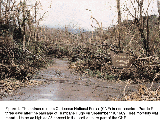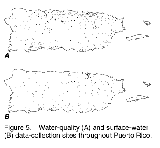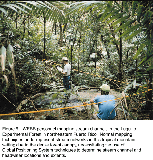|
|
For more than 100 years, the U.S. Geological Survey (USGS) has been
mapping, describing, and seeking to understand the Nation's natural
resources. The USGS is known for impartial data collection and
interpretation that enables resource planners and others to make informed
decisions. Today's issues are more pressing than ever-understanding
natural hazards to minimize their effects on life and property, the
continuing need for mineral- and water-resource development, and
understanding the effects of human activities on water and biological
resources.
As the Nation's lead natural science agency, the USGS works with
Commonwealth and other Federal agencies in addressing these issues in
Puerto Rico. USGS maps, interpretive reports, and data are used by
educators; municipalities; various local and Federal planning agencies;
consulting firms; farmers; and other private citizens to manage Puerto
Rico's resources.
|

|
|
|
|
Though frightening and economically damaging, hurricanes and other
high-energy storms are vital to the long-term health of delicate marine and
terrestrial ecologies in coastal areas (fig. 1). Marine geologists of the
USGS working in the Commonwealth of Puerto Rico are confident that the
long-term effects of Hurricane Hugo on the coastal environment are minimal,
although the economic damage was significant. As part of the continuing
research conducted in Puerto Rico, the shelf area offshore of the town of
Luquillo was mapped using high-resolution sonar, seismic-reflection
profiles, photographs, and bottom sampling following the passage of
Hurricane Hugo. Sea-floor structure, local geology, and sediment
characteristics indicate that a regional cross-shelf transport of sand
occurs during storms, but that it is trapped by ridges to form sand
deposits as much as 60 feet thick. Sand eroded from the beach front moves
offshore, and the pathways for that movement can be documented by using
remote imagery. |

(Larger Version, 291K GIF)
|
|
Figure 1. The entrance to the Caribbean National Forest
(CNF) in northeastern Puerto Rico three days after the passage of Hurricane
Hugo on September 18, 1989. Tree mortality was reported to be as high as
35 percent in the northeastern part of the CNF.
| |

|
|
|
|
High-energy storms also can bring large amounts of rainfall in very short
periods of time to mountainous regions of Puerto Rico. These events can
trigger hundreds of landslides, which are common in the mountainous areas
of Puerto Rico where mean annual rainfall and the frequency of intense
storms are high, and hillslopes are steep (fig. 2). Each year, landslides
cause extensive damage to property and occasionally result in loss of life.
Population density in Puerto Rico is high, 400 people per square kilometer,
and is increasing. This increase is accompanied by the use of less
desirable construction sites. As a result, human populations are becoming
more vulnerable to landslide hazards.

(Larger Version, 291K GIF)
|
|
Figure 2. Two debris avalanche scars along Highway PR191
in the Sierra de Luquillo, Puerto Rico, measuring 600 meters from the ridge
top to the two-lane highway visible in the foreground. The avalanches were
triggered by intense precipitation in 1970 and 1989 with rainfall totals of
300 to 900 millimeters.
|
The principal objective of a 3-year USGS study in the Río Blanco,
the Río Cibuco, and the Río Coamo Basins was to evaluate the
geographic relations of landslide distribution across the range of
topography, climate, soils, and bedrock geology that occur in Puerto Rico
(fig. 3). An additional objective was to determine the rainfall
accumulation and duration characteristics of storms likely to trigger
landslides in the central mountains of the island and to develop a
rainfall accumulation/duration
threshold relation for Puerto Rico.
|

(Larger Version, 194K GIF)
|
|
Figure 3. Location of Puerto Rico and various study sites.
|
Study results indicate that landslides in the Sierra de Luquillo and the
Sierra de Cayey consist mainly of shallow soil slips and debris flows with
an average volume of 120 cubic meters and can number as many as 20 per
square kilometer. The mass of eroded material can be as high as 6,000
metric tonnes per square kilometer. Because most of the soil eroded by
landsliding is delivered directly to river channels, fluvial sediment loads
can remain high for many months following large storms. For example, a
single landslide that occurred during Hurricane Hortense in the Río Icacos
watershed in El Yunque introduced a mass of soil into the river that is
equivalent to the average annual sediment yield for an entire year. The
geomorphic effects of such storms will be visible on hillslopes and river
channels for decades in the form of altered hillslope form and channel
morphology. These results provide land-use managers and public-safety
agencies with an inexpensive method that can be used to assess landslide
hazards in Puerto Rico. |

|
|
|
|
A record of historical shoreline positions and erosion rates has been
compiled for the area near Rincón, in western Puerto Rico, for 1950-94
(fig. 3). The study area includes approximately 8 kilometers of the
northwestern coast, from Punta Higüero to Punta Cadena (fig. 4).
Historical shoreline positions were obtained from aerial photographs. More
recent shoreline position surveys were conducted using a portable,
differential Global Positioning System.

(Larger Version, 194K GIF)
|
|
Figure 4. The shoreline in the study area was divided
into four distinct reaches based on erosion rates. The relative magnitude
of shoreline movement between 1950-1994 is depicted by the transect line
length. | |
Erosion rate data for Reach B indicate that there was a profound change in
the historical trend between 1977 and 1987. Before 1977, the erosion rate
in Reach B was about 0.5 ± 0.3 meters per year. From 1987 to 1994,
however, the erosion rate was more than 3.0 ± 1.0 meters per year. The
increased erosion correlates with the 1983 construction of a relatively
small marina within Reach B. Emplacement of a breakwater/jetty system and
the continued removal of dredged material at the marina entrance appear to
be the major contributing factors to the recent increase in erosion rates.
Human response to the increased rate of shoreline erosion has been a
piecemeal seawalling of the shoreline. If left unmiti-gated, continuing
shoreline stabilization with the piecemeal construction of seawalls and
revetments may result in the rapid destruction of local beaches. Manmade
stabilization structures also may reduce sediment supply to downdrift
beaches, thus increasing the erosion of beaches that are used for
recreation and tourism and that support a small, beach-based fishing
fleet.
|

|
|
|
|
Since 1958, the USGS, in cooperation with 15 local and Federal agencies has
been collecting a large amount of data pertaining to the water resources of
Puerto Rico. These data constitute a valuable data base for developing an
improved understanding of the water resources in Puerto Rico. These data
include records on surface and ground water, water quality, and
stream-sediment concentration and transport.
Surface water is a major source of drinking water, industrial supply, and
irrigation in Puerto Rico. The surface-water data-collection program (fig.
5B) measures stream discharge and the amount of rain falling in specific
river drainage basins. Water samples also are collected (fig. 5A) to
determine the physical, chemical, and bacteriological characteristics of
lakes, streams, and rivers. |

(Larger Version, 194K GIF)
|
|
Figure 5. Water-quality (A) and surface-water (B)
data-collection sites throughout Puerto Rico.
|
Long-term monitoring of ground-water levels gives insight into the
withdrawal and recharge rates of aquifers, and provides essential
information for managing these important water resources. The USGS
maintains a computer data base that contains information on the physical
and chemical characteristics of water in about 5,700 wells and springs in
Puerto Rico. |

|
|
|
|
Floods can be extremely destructive in Puerto Rico because of the island's
topography and dense population. Nearly 70 nonnavigable rivers and
streams-whose banks and drainage areas are dotted with
communities-originate in the central mountain range. The stream valleys
are narrow, relatively short, and steep-features that make the streams
susceptible to flooding, particularly flash flooding.
Flash floods typically result from rainfall that is intense in the upper
basins but that is sparse or nonexistent on the coast. Streams on the
south coast are more susceptible to flash flooding than those on the north
coast because of their shorter length and steeper gradient. Lag time from
the occurrence of intense rainfall to the peak discharge is, therefore,
least along the southern coastal plain.
Large areas of the coastal plain are subject to storm-surge flooding from
hurricanes and other tropical storms. The coastal plain also is vulnerable
to flooding by large coastal sea swells generated by winter storms over the
Atlantic Ocean. |
Although drought can be defined as a period of deficit in rainfall or water
supply for an extended period of time, there is no single commonly accepted
measure of drought in terms of water demand. In fact, there is no
quantitative definition of drought that is universally acceptable. Most of
the criteria used to identify drought have been arbitrary because a drought
is something of a nonevent, as opposed to a distinct event such as a flood.
Drought has no distinct onset and is recognizable only after a period of
time. In addition, this period of time is variable because the time
required for a drought to develop depends on many interacting variables.
Historically, droughts are rare in Puerto Rico (table 1). Significant
droughts in recent years that affected large areas of Puerto Rico over an
extended period of time occurred during 1966-68, 1971-74, 1976-77, and
1993-94. The 1971-74 drought was the most severe drought on record in
terms of streamflow deficits and duration, whereas the 1993-94 drought was
most severe in terms of water-supply problems. |

|

|
|
|
|
The humid tropics occupy 25 percent of the Earth's land surface and by the
year 2000 will contain approximately 50 percent of the Earth's population.
Rapid deforestation in the humid tropics is recognized as a threat to both
the economic development of the affected areas and to global climate.
Development stresses include major adverse effects on soils, soil
nutrients, surface-water quality, reservoirs, and increase the short-term
hazards of landslides and floods. To understand these processes and
provide information useful for developing solutions to these problems as
they may affect Puerto Rico, the USGS has developed a long-term Water,
Energy, and Biogeochemical Budget program (WEBB) research site in the
Sierra de Luquillo in eastern Puerto Rico. The site consists of the
11,300-hectare U.S. Forest Service-administered Luquillo Experimental
Forest and the Río Grande de Loíza drainage basin, an agriculturally
developed watershed.
The research work focuses on tropical geomorphic and biogeochemical
processes that control the movement and transformation of water, energy,
bedrock weathering products, and nutrients in the earth-surface environment
(fig. 6). Detailed data are being obtained on hillslope and fluvial
transport and erosion processes, soil-development, and nutrient cycling.
These data are being used to develop sediment and water budgets and a
geomorphic model of tropical landform development. This model can assist
resource managers in identifying planning solutions to reservoir
sedimentation, landslides, floods, and other development-related geomorphic
problems that occur in densely populated tropical settings. |

(Larger Version, 291K GIF)
|
|
Figure 6. WEBB personnel mapping stream channels in the
Luquillo Experimental Forest in northeastern Puerto Rico. Normal mapping
techniques underrepresent stream networks in this tropical mountain setting
due to the dense forest canopy, necessitating the use of Global Positioning
System techniques to determine stream channel and headwater locations and
extents.
| |

|
|
Among the most popular and versatile products of the USGS in Puerto Rico
are its 1:20,000-scale topographic maps (1 inch on the map represents about
1,667 feet on the ground). These maps depict basic natural and cultural
features of the landscape, such as mountains, lakes and streams, highways,
boundaries, and geographic names. Contour lines are used to depict the
elevation and shape of the terrain. Puerto Rico is covered by 67, which
are useful for civil engineering, land-use planning, natural-resource
monitoring, and other technical applications. These maps have long been
favorites with the general public for outdoor uses, including hiking,
camping, and exploring. |

|
|
Geologic mapping of Puerto Rico is now largely complete at a scale of
1:20,000. Work on compiling a digitized geologic map of Puerto Rico at a
scale of 1:200,000 as well as numerous other derivative maps that deal with
natural geologic economic resources and various mineral resources also is
underway. |

|
|
|
|
Through its Earth Resources Observation Systems Data Center near Sioux
Falls, South Dakota, the USGS distributes a variety of aerial photographs
and satellite image data products that cover the entire island of Puerto
Rico. Mapping photographs of some sites go back about 40 years. Satellite
images dating from 1972 can be used to study changes in regional
landscapes. |
The USGS and the U.S. Environmental Protection Agency are cooperating to
create computerized (digital) images from aerial mapping photographs of
Puerto Rico. These digital images will form a seamless data set for a
geographic information system useful for assessing potential hazards, such
as oil spills and non-point pollution sources, related to water
resources.
|







